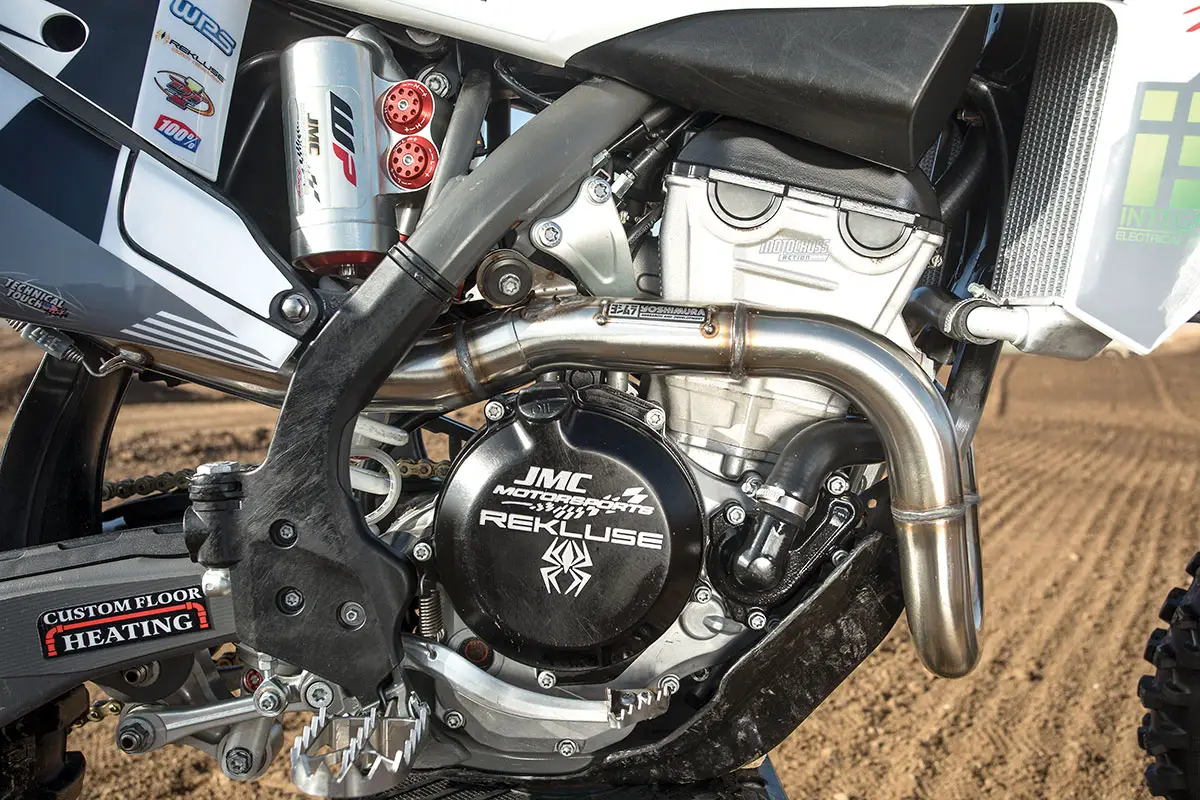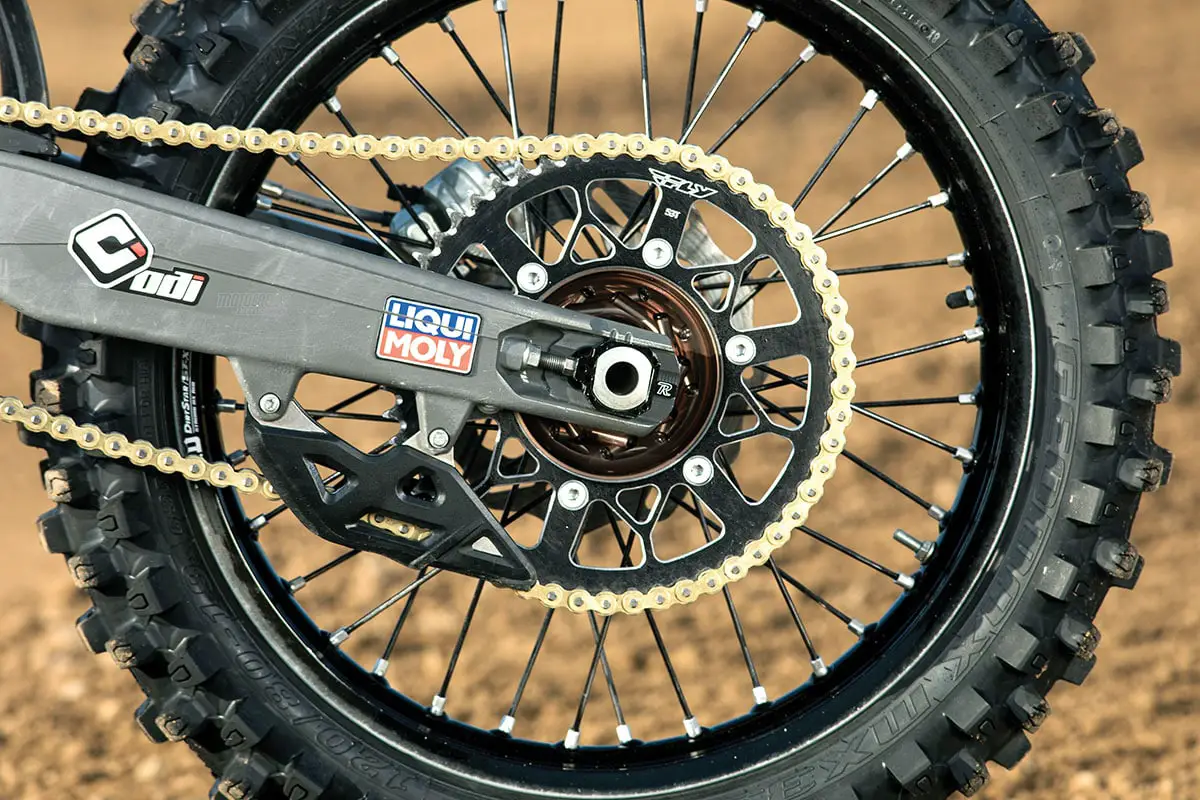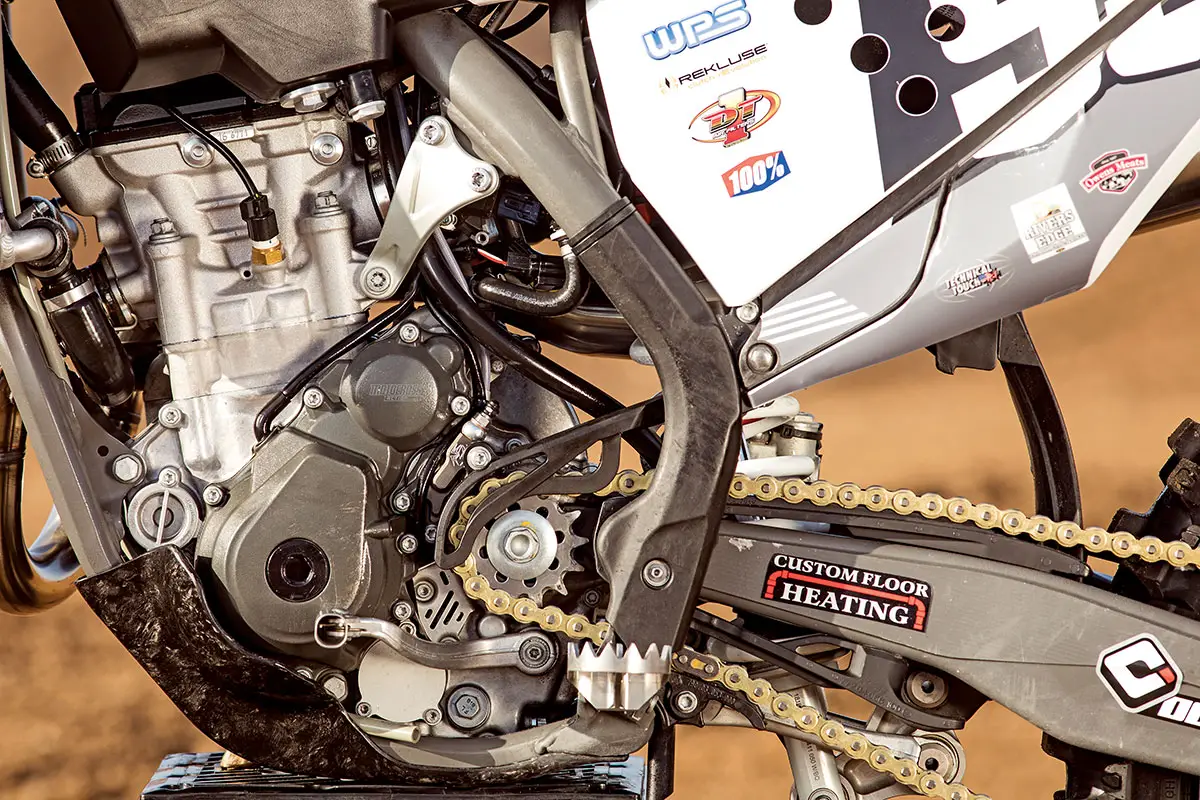WE RIDE CARSON BROWN’S JMC HUSQVARNA FC250

Goggles: EKS Brand Gox Flat-Out, Boots: Sidi Crossfire 3SR.
BY JOSH MOSIMAN
JMC Motorsports is a dealership based out of Pasco, Washington. The dealership first got into racing Supercross by supporting local racers Chris Howell and Noah McConahy in 2016. Originally, JMC helped Chris and Noah build race bikes to compete in the 250 West Coast Supercross series, but after going to Anaheim 1 in 2016, they realized that the guys needed more support than just bikes. The team started out slowly but grew every year from 2016 on. By the end of the 2018 season, they had bought a factory-style semi from the Canadian Leading Edge Kawasaki team and brought it to the Seattle, Salt Lake City and Las Vegas Supercrosses. In pro racing, it’s the semi that really makes you stand out in the pits, and by the time 2019 rolled around, the JMC Husqvarna team was operating at full force with its factory-style rig at the 250 West Coast rounds.
Operating a professional Supercross team is no small feat. Every year teams come and go. It’s a challenge to build a team from the ground up without factory support, but the JMC Husqvarna program has steadily continued to grow and evolve each year. The hard work is showing on the results sheets and in the team’s physical presence in the pits. Jensen Hendler is a big reason for the team’s progress. Not only is he the team manager, he is also the team’s engine builder and mechanic for Carson Brown. Jensen is a motor-head to the core. He works long hours to keep the team operating on all cylinders—and he loves it.
BBR IS KNOWN FOR BUILDING THE BADDEST PIT BIKES AROUND, AND AFTER GROWING UP UNDER HIS FATHER’S TUTELAGE, CARSON IS ONE OF
THE BEST PIT BIKE RIDERS IN THE WORLD.

At just 20 years old, Carson Brown’s name is famous in the Pacific Northwest, and his reach is growing as he continues to improve in Supercross. Carson’s dad, Duane Brown, and his two uncles, Chris and Brent, founded BBR Motorsports (Brown Brother’s Racing). BBR is known for building the baddest pit bikes around, and after growing up under his father’s tutelage, Carson is one of the best pit bike riders in the world. Over the years Carson’s riding style has developed to suit the bikes that he and his dad build, and it is reflected in the way he rides his FC250 as well. Carson eats, sleeps and breathes dirt bikes, even more than most guys his age. His backyard in Ravensdale, Washington, is a motocross rider’s playground where he can be seen riding all kinds of different bikes, from expensive one-off BBR builds to stock pit bikes to 125 two-strokes to a CR500 and his JMC race bike. If it has two wheels and an engine, Carson has most likely jumped it as far and high as it can go on his backyard Supercross track.
Carson signed with the JMC Husqvarna team to race the 2019 250 West Coast regional Supercross Championship, but his debut run at Supercross didn’t go as planned when a preseason wrist injury hindered him and eventually ended his season after round six. At that point, Carson was tired of riding in pain. He decided that he was going to do everything possible to be healthy and ready for the 2020 Supercross season. The JMC team was on the same page and ordered him to stay off pit bikes and focus solely on the FC250 going into 2020. Carson was hesitant, because he has so much fun building and riding random bikes, but he did what was necessary to get ready for the 2020 season. Now he’s thankful for it. Carson is stronger these days, and it’s showing in his results. At the first six rounds of the 2020 250 West Coast regional Championship, Carson was 15th, 9th, 12th, 11th and 8th in the 250 West main events.
It was on Monday after the Glendale Supercross when Jensen and Carson brought their JMC Husqvarna race bike out to SoCal’s State Fair MX Supercross track for me to test. The JMC team had a great run in Glendale, with Carson’s teammate Martin Castelo grabbing holeshots in two out of the three 250 main events during the triple-crown format. After seeing that, I was even more excited to try the bike. The JMC boys drove back to Southern California from Arizona on Sunday, and Jensen stayed up late to prepare the race bike for me to test bright and early on Monday morning.
JMC ALSO BUILT ITS OWN PRIVATE SUPERCROSS TEST TRACK IN MENIFEE, CALIFORNIA, JUST FOR ITS RIDERS TO PRACTICE ON. IT COSTS AT LEAST $75 A DAY TO RIDE ON SOCAL’S PUBLIC SUPERCROSS TRACKS (AND THERE ARE CURRENTLY ONLY TWO PUBLIC SUPERCROSS
TRACKS IN SOUTHERN CALIFORNIA).
After a few years of managing the JMC Husqvarna team and building its engines, Jensen Hendler has mastered his craft. Both Carson Brown and Martin Castelo rode for the team in 2019, and both have noticed huge improvements from last year to this year. One big change for 2020 was the addition of Tanner Harding, the team’s in-house suspension technician. The puzzle pieces all fit together when the former WP Suspension tech moved back home to the Pacific Northwest just as JMC Motorsports was looking for a in-house suspension guy to work on its customers’ suspension and to build suspension for the race team. Tanner Harding had worked for Kailub Russell in the KTM off-road division for five years then he moved to the WP Suspension shop in Murrieta, California for two years before heading back home.

In addition to the team growing on the mechanical side, JMC also built its own private Supercross test track in Menifee, California, just for its riders to practice on. It costs at least $75 a day to ride on SoCal’s public Supercross tracks (and there are currently only two public Supercross tracks in Southern California). Plus, the public tracks aren’t maintained like the factory test tracks. By the middle of the season, they are worn down and unrealistic compared to the actual AMA Supercross tracks they have to race on. With both the suspension and engines being built in-house and its own private Supercross track, the JMC team was truly able to determine its own destiny.
Before I started working at Motocross Action magazine, I raced the AMA Nationals for two and a half seasons and did one season of Supercross in 2018. Coming into this test day, I hadn’t been on a Supercross track since the Las Vegas finale in 2018. I was nervous and excited when I showed up to State Fair MX to ride Carson Brown’s JMC Husky. Initially, when I jumped on the bike to check the sag, I noticed right away that Carson’s bars weren’t as bad as I expected. We had tested Carson’s 2018 Red Bull Straight Rhythm-winning TC150 two-stroke, and he had his handlebars rolled back farther than any other bike I’ve ever sat on, with levers that angled up. For Carson’s FC250 Supercross bike, he had brought his bars forward into a more neutral position, but they were still farther back from my preferred position, and his levers were too high for my liking. I like my handlebars to come up at the same angle as the forks and my levers lower than most to keep my elbows up. Carson explained that his oddball handlebar and lever setup is inspired by his love for pit bikes. Because he has spent so much time going wide open on miniature dirt bikes, his riding style has been adjusted to suit them, and he likes his race bike to have a similar feeling.
WATCHING CARSON RIDE, IT’S OBVIOUS THAT HE LIKES TO RIDE ON THE REV LIMITER. HE SAID THAT WITH HIS BACKGROUND OF RIDING 125
TWO-STROKES AND PIT BIKES, HE IS COMFORTABLE RIDING
HIGHER IN THE RPM RANGE THAN MOST RIDERS.
Next, I noticed how stiff the suspension was. Not being on a Supercross-suspended bike in some time, I forgot just how stiff they must be. Jensen informed me about how stiff Carson likes his suspension, and he wasn’t kidding. I could barely compress it while sitting in the pits, but I did appreciate it once out on the track. Carson and I were close enough in weight that we didn’t need to adjust the sag. I left it right where it was (103mm). I also noticed the sheer torque and power the FC250 had off the bottom. Just riding it through the pits made me excited. Before hitting the Supercross track on an unfamiliar bike, I jumped on State Fair’s outdoor track for three laps to get a feel for it on a course where the consequences for a mistake were much less severe. After spending three laps getting comfortable with the power curve, suspension, brakes and everything else, I was off to the big-boy track.

I took it easy and found my rhythm slowly. As on all Supercross tracks, the jumps were right out of the corners, which meant I had to be committed. The first time I jumped the big triple, I came up 3 feet short, so I was thankful for Carson’s ultra-stiff suspension. While I was getting my bearings back on the tight and technical track, I defaulted to the smooth, low-revving riding style that my brother, Michael Mosiman, is known for. When I pulled off, the guys talked with me about how I needed to rev the bike to get into the meat of the powerband. I was actually riding a gear higher than Carson around the whole track, and we were shocked that the bike was able to do that. Carson was riding the whole track in second gear (except for the whoops, where he was using fourth), and he was hammering the throttle aggressively. I was riding the track in third gear and using the clutch to modulate the power. Everyone was impressed that the bike could pull third gear on the tight track, and I was, too. The only reason third gear on the 250 could work on a Supercross track was because of the extremely strong bottom end. Jensen Hendler had done such a good job of creating bottom-end power that they tested lots of different gearing ratios ending up with a 14/52 ratio to smooth out the torque and get some more top end out of it for starts.

Watching Carson ride, it’s obvious that he likes to ride on the rev limiter, and when I asked him about his style, he confirmed it. He said that with his background of riding 125 two-strokes and pit bikes, he is comfortable riding higher in the rpm range than most riders. He’s happy about the bottom end that his bikes have for 2020, and he gave credit to Jensen for improving it significantly over the 2019 engines. For me, I usually ride lower in the rpm range until I get comfortable, and as my confidence grows, my revs get higher. After watching Carson spin more laps, I did my best to adopt his riding style and stay in second gear. I could do it, but with the quick-turn throttle tube that they added (to help with Carson’s limited range-of-motion in his wrist) and the hard-hitting bottom end, it was a challenge for me to ride in that zone. I also found that it was much easier to make a mistake riding in second gear. I was comfortable in third gear, using the clutch to liven the bike up whenever needed.
As far as engine modifications go, Team Manager Jensen Hendler did everything himself. He CNC-ported the cylinder head, added a Wossner piston, and built it to his own specs. He took out the neutral shift star and did all of the Vortex ECU mapping as well. He added a Rekluse torque-drive clutch and clutch slave cylinder and a 42mm throttle body. Trick Engineering micro-polished the transmission, DG2 Motorsports put a cerakote coating on the ignition cover and also powder coated the frame and swingarm. Jensen has been working closely with Yoshimura to tailor the RS-4 exhaust system to the FC250 powerplant.
The power on the JMC Husqvarna FC250 was a blast to ride, and it all made sense that Martin Castelo was able to grab two main event holeshots on the 429-foot start straightaway at the Glendale triple crown. Jensen must have been proud to see the engines he built holeshot the factory boys on one of the longest starts in Supercross history.
JMC’s Tanner Harding built the suspension in-house with the 48mm WP XACT Pro Cone Valve forks and the XACT Pro 2.0 Trax Shock. With the addition of Harding for 2020, the riders have enjoyed the ability to test suspension settings much more. This season, Carson has continued to go stiffer and stiffer with his suspension settings, and he’s happy about it.
As far as the other chosen parts go, X-Trig’s triple clamps were used with PHDS bar mounts from Technical Touch. Carson used McGrath-bend ODI Podium bars with ODI’s standard grips, ARC levers and a quick-turn throttle tube. Dubya USA built up the wheels with D.I.D. Dirt Star ST-X rims, Talon ultralight hubs and OEM Husqvarna Rockstar-edition spokes. Dunlop provided Carson with factory-spec MX33 front tires and a production MX33 rear tire. The JMC team also used Fly Racing sprockets and HRC Honda rear axles with Ride Engineering axle blocks. A 270mm Braking Batfly front brake rotor was used, while Pro-X CNC billet stainless steel foot pegs keep Carson’s feet on the bike. Acerbis provided the plastics. Graphics Dynamic Designs made the stickers, and Guts Racing did the seat cover.

I really enjoyed my time riding Carson Brown’s JMC Husqvarna race bike. When I stopped racing the AMA Pro circuit full-time and began working at MXA, I didn’t have any plans to race Supercross again. Modern AMA Supercross tracks are no joke, and it would take months of dedicated preparation for me to be willing to line up in a stadium again, but I never wrote off the idea of getting on a Supercross practice track again. It’s much more relaxed and fun to ride on a practice track than it is a full-blown stadium track because you can take your time to get comfortable. I also enjoyed learning about all that Jensen and the JMC team have done to build a bike that has been proven to score holeshots and top-10 finishes in 250 main events. Learning about what other people like their bikes to feel like helps me figure out what I like.











Comments are closed.